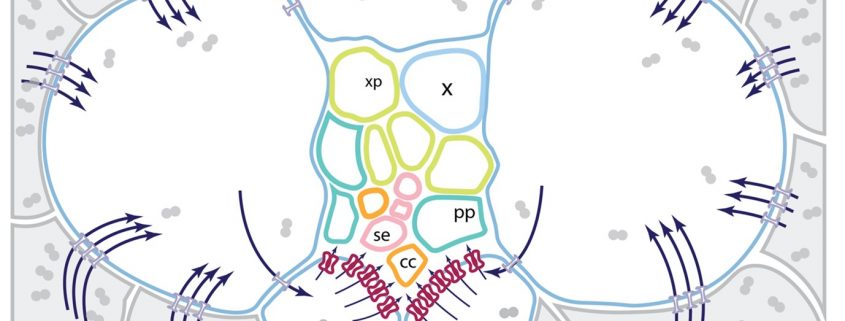A SWEET route for phloem loading in maize
Bezrutczyk et al. use single cell RNA-seq to show that SWEET13 proteins in maize bundle sheath cells are specialized in nutrient transport to the phloem. Plant Cell. https://doi.org/10.1093/plcell/koaa055.
By Margaret Bezrutczyk and Wolf B. Frommer, Institute for Molecular Physiology, Heinrich-Heine-University Düsseldorf, Düsseldorf 40225, Germany
Background: Maize is among the most productive crop plants. Maize leaf mesophyll cells synthesize sucrose, the transport form of carbohydrates. Sucrose is then translocated from the mesophyll cells to the sieve-element companion cells for export to sink tissues in organs such as roots and developing seeds. Although three maize sucrose uniporters (SWEET13a, b, and c) were shown to be critical for leaf sucrose export, the complete source-to-sink route in maize is not fully understood. In barley, it appears that a subset of bundle sheath cells are specialized for translocating nutrients into the vein for export. Here, we used a combination of single-cell RNA sequencing and in situ hybridization to try to reconstruct the route in maize.
Questions: Can we identify key steps in the translocation route that transports sucrose from the mesophyll to the sieve element companion cell complex? Are all maize bundle sheath cells the same, or is there a subset of bundle sheath cells that is specialized in sugar translocation in maize plants?
Findings: Using single cell sequencing combined with in situ hybridization and analysis of translational report fusions, we identified abaxial bundle sheath cells as being specialized in nutrient transport. Transcripts of SWEET13a, b, and c, as well as other sugar and amino acid transporters, were enriched in the abaxial bundle sheath cells. This indicates that maize has developed a new route for transferring sucrose from the large surface area of the two ventral bundle sheath cells to the phloem.
Next steps: Can we observe sucrose gradients in a maize leaf? Do these SWEET uniporters show polar localization in the plasma membrane facing the phloem? Is the pattern similar in the maize ancestor teosinte and in related species? How did this feature evolve, and could it be used to increase productivity of other crops?
Margaret Bezrutczyk, Nora R. Zöllner, Colin P. S. Kruse, Thomas Hartwig, Tobias Lautwein, Karl Köhrer, Wolf B. Frommer, and Ji-Yun Kim. (2021) Evidence for phloem loading via the abaxial bundle sheath cells in maize leaves. Plant Cell. https://doi.org/10.1093/plcell/koaa055




